Australians for Constitutional Monarchy facts for kids
 |
|
| Formation |
|
|---|---|
| Founders |
|
| Registration no. |
|
| Legal status | Public company limited by guarantee (1993–present) |
| Purpose | Advocacy for the preservation of Australia's existing constitutional monarchy |
|
National Convener
|
David Flint (Since 1998) |
|
Executive Director
|
Jai Martinkovits (since 2011) |
|
Young National Convener
|
Daniel Lahood |
Australians for Constitutional Monarchy (ACM) is a group that wants to keep Australia's current system of government. This system is called a constitutional monarchy. It means Australia has a King or Queen, currently Charles III, as its head of state.
ACM says it's a group that doesn't pick sides in politics. It's also a not-for-profit organisation. Their main goal is "To preserve, to protect and to defend our heritage: the Australian constitutional system, the role of the Crown in it and our Flag". This means they work to protect Australia's traditions and its way of being governed.
Contents
What ACM Has Done
Australians for Constitutional Monarchy held their very first public meeting in Sydney in June 1992. About 450 people came to this important event. Many well-known Australians were part of the group's first council. These included Sir Harry Gibbs, who was a top judge, and Dame Leonie Kramer, who led Sydney University.
The 1999 Republic Vote
In 1999, Australia had a big vote called a republic referendum. People voted on whether Australia should become a republic. A republic would mean having a president instead of a King or Queen.
ACM played a very important part in the "No Republic" campaign. This campaign wanted Australia to keep its King or Queen. Kerry Jones, who was ACM's Executive Director, led the official "Vote No" team. The "Vote Yes" team, which wanted a republic, was led by Malcolm Turnbull.
ACM had a lot of support, with over 50,000 people helping their campaign across Australia. In the end, 55% of Australians voted "No" in the referendum. This meant Australia stayed a constitutional monarchy.
Protest at Government House
In 1996, ACM also organised a big public protest in Sydney. This was because the New South Wales Governor, Gordon Samuels, was asked to move out of Government House. This is a special building where the Governor lives and works.
More than 20,000 people joined the protest march. It was the biggest protest of its kind in Australia. ACM kept campaigning about this issue. In 2011, the Premier of New South Wales, Barry O'Farrell, agreed to let Governor Marie Bashir move back into Government House. ACM saw this as a big win for their cause.
Who Leads ACM?
ACM has had important leaders since it started. The first leader, called the National Convener, was Lloyd Waddy. He led the group from 1992 to 1998.
Since 1998, Professor David Flint has been the National Convener. He continues to lead the organisation today. Other key people include Jai Martinkovits, who has been the Executive Director since 2011, and Daniel Lahood, the Young National Convener.
What ACM Does Now
Today, ACM continues to work hard to keep Australia as a constitutional monarchy. They describe themselves as a "grassroots community organisation." This means they are made up of everyday people working together.
One of their main activities is sharing information. They publish news and facts about Australia's constitution, its government, and the role of the King or Queen. You can find this information on their official website: http://www.norepublic.com.au. They also publish books and articles about these topics.
ACM also holds events all over Australia every year. Their biggest event is an annual national conference. Many important people from Australia have spoken at these conferences. These include former Prime Minister John Howard. The last National Conference was held in Sydney in November 2021. ACM is proud to be the only group, whether they support the monarchy or a republic, to have held a national conference every year since the 1999 referendum.
Why ACM Believes in the Monarchy
ACM has strong reasons for wanting to keep Australia's constitutional monarchy.
They argue against ideas from some people who want a republic. These people suggest having many votes to change the constitution. ACM believes that all the details of any big change should be clear *before* people vote, not after. They say that those who want a republic often don't have a clear plan for what a republic would look like.
ACM also works to stop what they call a "republic by stealth." This means they oppose small changes that slowly remove the King or Queen from Australian life. For example, they have fought against removing references to the Crown from laws or changing titles like King's Counsel. Their successful campaign to return the Governor of New South Wales to Government House is an example of this.
Another example of their work was during the 2006 Commonwealth Games in Melbourne. ACM objected when organisers planned not to play the Australian Royal Anthem at the opening ceremony, even though the Queen was there. Young ACM supporters handed out song sheets so people could sing the anthems. In the end, part of the Royal Anthem was played.
Who Are ACM Members?
ACM has many members who support their goals. The group also has members who help with the financial and management side of the organisation.
Many important Australians have been part of ACM since the beginning. These include Michael Kirby, a former Justice of the High Court, and Neville Bonner, who was the first Indigenous Australian to become a Member of Parliament.
Tony Abbott, who later became the Prime Minister of Australia, was ACM's first National Executive Director from 1992 to 1994. During his time, a group for young people under 30, called Young Australians for Constitutional Monarchy, was started.

See also
- Australian Monarchist League
- Australian Constitution
- Australian Constitutional history
- Constitutional Monarchy
- Australian republicanism
- Australian Republican Movement

